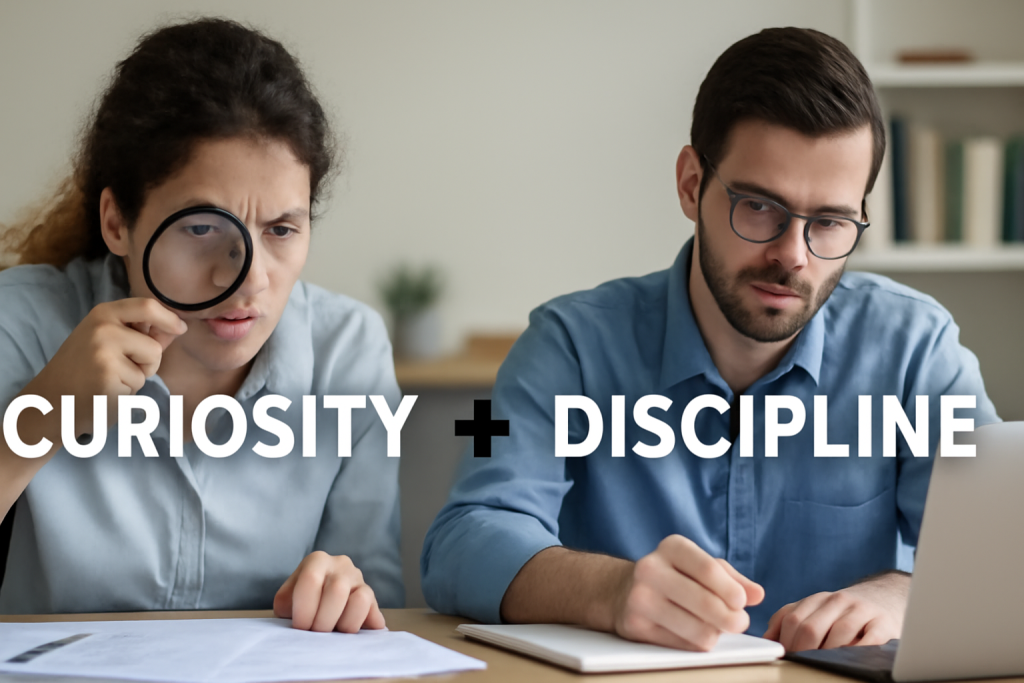How to Mix Curiosity and Discipline
Jessica White July 24, 2025
Struggling to maintain momentum? You’re not alone. Many successful individuals attribute their growth to the perfect blend of curiosity and discipline. This powerful combo sparks creativity while driving focused action. Want to know how to harness both? Let’s dive into this game-changing approach.

The Power of Curiosity and Discipline: A Balancing Act
In today’s fast-paced world, staying curious and maintaining discipline can feel like a tug-of-war. Curiosity fuels innovation and sparks new ideas, while discipline ensures you remain focused and follow through on your goals. The question many ask is: How can we mix the two effectively?
If you’ve ever started an exciting project full of ideas and passion, only to lose steam halfway through, you’ve likely encountered the need to balance curiosity with discipline. Curiosity pushes you to explore, to ask questions, and to take risks, while discipline keeps you grounded and on track to turn those explorations into reality.
Curiosity: The Spark That Ignites Your Passion
It drives exploration, learning, and the desire to understand more. It’s about asking questions, seeking new knowledge, and staying open to new ideas. In the realm of personal and professional growth, curiosity is the first step toward breakthrough moments. Whether it’s a passion for a new hobby or a drive to find innovative solutions at work, curiosity keeps you moving forward.
Curiosity is the engine that powers new ideas, pushing you to think outside the box. It invites you to break free from conventional methods and discover new ways to approach challenges. In fact, according to a recent study by Stanford University, curiosity has been shown to significantly enhance memory retention and creativity, making it an indispensable tool for learning and development (Stanford, 2023). People who actively seek new experiences and information tend to be more adaptable and innovative in their work and personal lives.
For example, imagine a scientist investigating a complex biological problem. Their curiosity leads them to explore new methods of research, test hypotheses, and uncover unique insights. But without the discipline to follow through on their experiments and manage the process meticulously, their curiosity could remain unproductive. Discipline, therefore, ensures that curiosity doesn’t remain a fleeting spark but instead fuels long-term success.
Discipline: The Structure That Turns Ideas into Action
While curiosity provides the spark, discipline offers the structure. Discipline is the commitment to do what is necessary, even when motivation is low. It’s about consistency, developing good habits, and staying focused on long-term goals. Without discipline, the enthusiasm of curiosity can quickly fade into procrastination or a lack of follow-through.
In the world of high achievers, the one common trait among them all is discipline. It’s the ability to keep pushing forward, even when the excitement fades and the initial curiosity begins to wane. According to recent research from the University of Michigan, individuals with higher levels of self-discipline tend to experience more success in both academic and professional environments, as they can consistently apply themselves to tasks even in the face of challenges (University of Michigan, 2022).
For example, consider someone learning a new language. The initial excitement and curiosity about mastering a foreign tongue might fade after the first few weeks. However, it’s discipline that keeps them coming back to study the language every day. Discipline ensures that curiosity leads to tangible results, whether it’s fluency in a language or the completion of a challenging project.
How to Combine Curiosity and Discipline for Maximum Results
The key to success lies in striking the right balance between curiosity and discipline. When combined correctly, these two qualities form a powerful partnership that can lead to extraordinary personal growth. But how exactly can you mix curiosity and discipline to maximize your results?
Here’s how to blend curiosity and discipline for optimal success:
1. Set Clear, Actionable Goals
Curiosity should be your guide to discovering what excites and interests you. Once you’ve identified those passions, discipline comes into play by setting clear, actionable goals. Instead of just “learning something new,” define what success looks like. This could be anything from mastering a new skill to completing a project.
For example, if you’re curious about learning how to code, set specific goals like “Complete a Python course in three months” or “Build a personal website by the end of the year.” These goals give your curiosity a clear direction and timeline, while discipline ensures that you stay focused on achieving them.
2. Foster a Routine that Encourages Discovery
It’s easy to get lost in the pursuit of knowledge. Create a routine that allows for both curiosity and discipline to coexist. Schedule time for exploration but also stick to a structured approach that ensures you stay on track.
For instance, you might reserve an hour each day for reading new materials, but also establish a habit of taking notes or writing summaries afterward. This routine ensures that your curiosity leads to deeper understanding, while discipline helps you retain and apply what you’ve learned.
3. Break Big Ideas into Manageable Tasks
Big, curious ideas can often feel overwhelming. The key to following through is breaking down those larger concepts into manageable tasks. This is where discipline shines—by setting daily or weekly targets, you make your goals feel attainable while staying aligned with your curiosity.
For example, if you’re curious about starting a podcast, break down the process into smaller, more manageable tasks like “Choose a podcast topic,” “Record the first episode,” and “Create a logo.” Discipline helps you focus on completing each task rather than getting overwhelmed by the bigger picture.
4. Embrace Failures as Learning Opportunities
Curiosity invites us to try new things, and with new ventures come inevitable failures. Rather than getting discouraged, use these failures as learning opportunities. Discipline will help you stick to the process, even when results aren’t immediately visible.
For example, an entrepreneur launching a new product may face setbacks like poor sales or negative feedback. Instead of giving up, they use their curiosity to learn from the mistakes and adapt their strategy, all while maintaining the discipline to continue improving.
5. Seek Feedback to Improve
Curiosity doesn’t just end with initial discovery. It involves seeking feedback and adapting based on new insights. Implementing regular self-assessment practices helps refine your discipline, pushing you closer to your ultimate goals.
For example, if you’re learning to play an instrument, seeking feedback from a mentor or recording yourself regularly can help you refine your technique. Discipline ensures that you continue practicing and applying the feedback, which in turn accelerates your growth.
Real-Life Examples of Curiosity and Discipline in Action
Steve Jobs, the co-founder of Apple, was a master of combining curiosity with discipline. His relentless pursuit of innovation, paired with the disciplined execution of his ideas, led Apple to become one of the most influential companies in the world. Jobs’s curiosity about technology, design, and human behavior led him to revolutionize multiple industries. But it was his discipline in refining his ideas and focusing on quality that turned his vision into reality.
Another example is Elon Musk. Musk’s curiosity about space, renewable energy, and artificial intelligence has led him to create companies like SpaceX and Tesla. However, his disciplined approach to setting long-term goals and tirelessly working towards them has been the key to turning his curiosity into groundbreaking innovations.
Key Takeaways
To truly unlock your potential, you must learn to mix curiosity and discipline. Curiosity opens the doors to new possibilities, while discipline ensures that you’re able to walk through them and create lasting results. By incorporating both into your routine, you’ll be empowered to explore, innovate, and execute in ways that lead to tangible success.
It’s not about choosing one over the other—it’s about harmonizing curiosity with discipline to achieve your full potential. Curiosity fuels the passion to start new endeavors, while discipline ensures that those endeavors are brought to completion.
References:
- Stanford University. (2023) The Science of Curiosity: How It Boosts Creativity and Learning. Available at: https://www.stanford.edu (Accessed: 24 July 2025).
- University of Michigan. (2022) The Role of Self-Discipline in Achieving Academic Success. Available at: https://www.umich.edu (Accessed: 24 July 2025).
- Duckworth, A. (2016) Grit: The Power of Passion and Perseverance. New York: Scribner. Available at: https://www.simonandschuster.com (Accessed: 24 July 2025).







